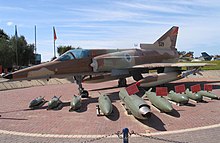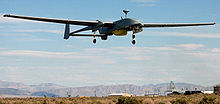Defense industry of Israel
The defense industry of Israel is a strategically important sector and a large employer, as well as a major supplier of the Israel Defense Forces. The country is one of the world's major exporters of military equipment, accounting for 10% of the world total in 2007. Three Israeli companies were listed on the 2022 Stockholm International Peace Research Institute index of the world's top 100 arms-producing and military service companies: Elbit Systems, Israel Aerospace Industries and RAFAEL.[1] It is also a major player in the global arms market with a 2.3% share of the global exports of major arms as of 2023.[2] Total arms transfer agreements topped $12.9 billion between 2004 and 2011.[3] There are over 150 active defense companies based in the country with combined revenues of more than $3.5 billion annually.[4] Israeli defense equipment exports reached $7 billion in 2012, making it a 20 percent increase from the amount of defense-related exports in 2011. With the war in Ukraine, arms exports reached $12.5 billion in 2022.[5] Much of the exports are sold to the United States and Europe. Other major regions that purchase Israeli defense equipment include Southeast Asia and Latin America.[6][7][8] India is also major country for Israeli arms exports and has remained Israel's largest arms market in the world.[9][10]
History
1930-1970
The manufacture of small weapons and explosives for the forerunners of the IDF had begun in secret arms factories during the 1930s.
1970s
By the mid- to late 1970s, Israeli suppliers were delivering an increasing share of the IDF's major weapons systems.
Domestic production reduced foreign exchange costs for imports, provided a degree of self-sufficiency against the risk of arms embargoes, and facilitated the adaptation of foreign equipment designs to meet Israeli requirements.[12] A high concentration of well-qualified scientists, engineers, and technicians, a growing industrial base, and a flow of government resources toward military research and development facilitated the rapid expansion of locally produced military equipment.[12] Officials asserted that spinoffs from the arms industry, especially in electronics, had stimulated the civilian high technology sector, thus contributing indirectly to export earnings.[12] This claim has been disputed by Israeli economists who concluded that the US$700 million spent annually on military research and development would have produced five times the value in export earnings had it been spent directly on civilian research and development.[12] Even among government leaders, there was growing realization that the defense industry had become too large and that the government should not be obliged to come to the rescue of large defense firms in financial difficulty.[12]
1980s

In 1988, Israel's more than 150 defense and defense-related firms (thousands of other firms were engaged in subcontracting) fell into one of three ownership categories: state-owned enterprises, privately owned firms, and firms with mixed state and private ownership.[12] One firm, Armament Development Authority, commonly known as Rafael, was the main military research and development agency responsible for translating the ordnance requirements of IDF field units into development projects.[12] Rafael had a unique status under the direct supervision of the Ministry of Defense.[13]
Total employment in the defense sector reached a peak of 65,000 persons in the mid-1980s, more than 20 percent of the industrial work force.[13] By 1988, however, retrenchment of the defense budget and shrinkage of the world arms market had exposed the defense industry to severe financial losses and layoffs that reduced the work force to about 50,000 employees.[13]
The largest of the defense firms was the government-owned conglomerate,
The factories of Israel Military Industries (IMI), another government-owned conglomerate, produced the Uzi submachine gun, the
Growth of the defense industry was achieved by a mixture of imported technology and Israeli innovation.[13] Israeli firms purchased production rights and entered into joint ventures with foreign companies to manufacture both end products and components.[13] Nearly every electronics firm had links of some sort with United States producers.[13] Purchase agreements for foreign military equipment frequently specified that production data and design information, together with coproduction rights, be accorded to Israel.[13] Nevertheless, American firms often were reluctant to supply advanced technology because of fears that Israel would adapt the technology for use in items to be exported to third countries on an unrestricted basis.[13] Some American firms also feared that collaboration would encourage Israeli competition in already saturated world markets.[13]
The Lavi Program

In 1980 the Government of Israel took the decision to use the experience IAI had accumulated to develop and manufacture a modern fighter plane to be the mainstay of the
In August 1987, after extensive government deliberations, the decision was made (by one vote) to cancel the Lavi program, due to the questioning of Israel's economic ability to support the cost of such an extensive program.[15] This led to a serious crisis at IAI which necessitated a major reorganization of the company's structure and business strategy; the company's work force of more than 22,000 people, was cut by 5,500 in 1988. However, the Lavi program was credited with developing a number[vague] of advanced technologies that IAI was able to market.[14]
Foreign military sales and assistance
By the late 1980s, Israel had become one of the world's leading suppliers of arms and security services, producing foreign exchange earnings estimated at US$1.5 billion annually, which represented one-third of the country's industrial exports.
Initially, most of Israel's arms sales were to Third World countries, but, owing to financial difficulties faced by these clients and to competition from new Third World arms producers such as Brazil and Taiwan, different sales strategies had to be adopted.[16] In part through joint ventures and coproduction, Israel succeeded in breaking into the more lucrative American and West European markets.[16] By the early 1980s, more than fifty countries on five continents had become customers for Israeli military equipment.[16] Among Israel's clients were communist states (China and Romania), Muslim states (Morocco, Turkey, Indonesia, and Malaysia), and so-called pariah states (South Africa and Iran).[16] To some degree, Israel was restricted in its marketing by United States controls over arms transactions involving the transfer of components or technology of United States origin.[17] In one well-publicized case, the United States vetoed the sale of twelve Kfir fighters to Uruguay in 1978. Intimidation of potential buyers by Arab states also presented a problem.[17] Observers believed that Arab pressure played a part in decisions by Austria and Taiwan not to purchase the Kfir and in Brazil's decision not to choose the Gabriel missile for its navy.[17]
The broader issues of Israel's foreign military sales program were decided by a cabinet committee on weapons transfers. Routine applications to sell arms to countries approved by this committee were reviewed by the Defense Sales Office of the Ministry of Defense.[17] The primary concerns were that arms supplied by Israel not fall into the hands of its enemies and that secret design innovations not be compromised.[17] After 1982, however, security restrictions were relaxed to permit export of high technology weapons and electronics.[17]
In the 1980s,
Military cooperation between Israel and Iran had been extensive since the 1960s, under the shah's regime.
Prior to the mass severance of diplomatic relations with Israel after the October 1973 War, Israel had actively promoted military collaboration with a number of African countries.[18] Training or advisory missions had been established in at least ten African states.[18] During the 1980s, Israel quietly resumed these activities in several places, most notably Zaire.[18] Israel dispatched teams there to train elite units and to help reorganize and rearm a division deployed in Shaba Province.[18] Israel also equipped and trained Cameroon's presidential guard unit.[18] Limited pilot training programs were extended to Liberia and to Ciskei.[18]
The US and Israel generally are considered allies and thus have many strong ties through defense industry, but there have been notable controversies over the years and at present. These have included the 'Dotan Scandal' of diverted funds and violations of the US
Aerospace

Israel Aerospace Industries or IAI (תע"א) is Israel's prime aerospace and aviation manufacturer, producing aerial systems for both military and civilian usage. It has 16,000 employees as of 2007. IAI is wholly owned by the government of Israel.
Israel is considered to be the leading
Major manufacturers

In 2005, the "Magen" Small Arms Division of IMI was privatized, and named Israel Weapon Industries (IWI). IWI is part of a group of companies that develops and manufactures a wide array of guns and rifles used by armies and law enforcement agencies around the world.[24]
See also
Further reading
- ISBN 1250822475.
References
- ^ SIPRI Top 100 Arm-Producing and Military Service Companies SIPRI. Retrieved 2024-02-14.
- ^ Trends in International Arms Transfers, 2022. SIPRI.doi.org/10.55163/CPNS8443
- ^ Israel among top arms exporters and importers – JPost – Defense
- ^ Thenakedfacts
- ^ Fabian, Emanuel. "Israeli arms sales doubled in a decade, hit new record of $12.5 billion in 2022". www.timesofisrael.com. Retrieved 2023-07-24.
- ^ Defense equipment and arms exports from Israel to reach $7 billion in 2012 1101134 - Army Recognition[permanent dead link]
- ^ Israel's arms exports increased by 20 percent in 2012 - Israel News | Haaretz Daily Newspaper
- ^ Israel's arms industry hoping success of Iron Dome will bring it sales - Israel News | Haaretz Daily Newspaper
- ^ Israel & India: New Allies | Brookings Institution
- ^ $10 bn business: How Israel became India’s most important partner in arms bazaar - Economic Times
- ^ a b c Metz 1990, p. 314.
- ^ a b c d e f g h i j k l m n Metz 1990, p. 315.
- ^ a b c d e f g h i j k l m n o p q Metz 1990, p. 316.
- ^ a b Arens, Moshe (5 August 2004), "The Arrow, the Ofeq reconnaissance satellite, and the Lavi fighter are the three great Israeli technological projects in the past 25 years", Haaretz
- ^ ""התעשייה האווירית לישראל" לביא". Israeli Air Force Site. Retrieved 29 December 2012.
- ^ a b c d e f g h i j Metz 1990, p. 318.
- ^ a b c d e f g h i j k l m n o p Metz 1990, p. 319.
- ^ a b c d e f Metz 1990, p. 320.
- ^ Kumaraswamy, Dr. P.R. "Israel-China Relations And The Phalcon Controversy". Middle East Policy Counsel. 12 (Summer 2005).
- ^ Bowman, Bradley; Gabel, Andrew (7 November 2019). "Deeper Partnership With Israel Can Help U.S. Solve Defense Dilemma". FDD.org. Foundation for Defense of Democracies.
- ^ Freedberg Jr., Sydney J. (February 18, 2020). "'Furious' US Presses Israel To Bar Chinese Gear From Sensitive Systems". Breaking Defense.
- ^ Israel builds up its war robot industry. United Press International. April 26, 2013.
- ^ “Israel – an unmanned air systems (UAS) super power”. Defense Update.
- ^ Israel Weapon Industries website Archived 2013-04-04 at the Wayback Machine
- ^ "Dun & Bradstreet: Rafael Company Profile". Archived from the original on 2013-05-14. Retrieved 2013-05-05.
Works cited
- OCLC 44197966.)
 This article incorporates text from this source, which is in the public domain.
This article incorporates text from this source, which is in the public domain.{{cite encyclopedia}}: CS1 maint: postscript (link
